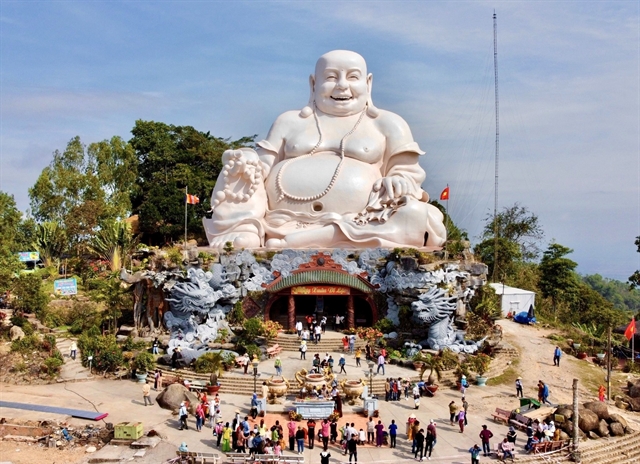Cửu Long (Mekong) Delta provinces have prepared new and diverse tourism products to lure more local and foreign tourists.

BIG BUDDHA: The 33.6m-high statue of Laughing Buddha in Cấm Mountain in An Giang Province is one of the most-visited spiritual tourism sites in the Mekong Delta. VNA/VNS Photo by Võ Thanh Sang
Mekong Delta provinces have created new and diverse tourism products to lure more local and foreign visitors.
Đào Sĩ Tuấn, deputy director of An Giang Province’s Culture, Sports and Tourism Department, said the province invested in upgrading infrastructure, renovating landscapes, and creating new food and shopping services.
An Giang, which is famous for pagodas, cajuput forests and lakes, spent VNĐ80 billion (US$3.4 million) on renovation of the Cấm Mountain Tourist Area, one of the most-visited spiritual tourism sites in the region.
Mt Cấm is one of the highest in the province, which fascinates visitors with its beautiful landscapes and cool weather.
It is also known for the Vạn Linh Pagoda, where the 33.6m-high statue of Laughing Buddha attracts hundreds of thousands of pilgrims and visitors.
Another famous spiritual tourism site in An Giang is the Temple of Bà Chúa Xứ (the local tutelary goddess) at the foot of the Sam Mountain in Châu Đốc City.
The Bà Chúa Xứ Festival held between the 23rd and the 27th of the fourth lunar month was recognised as a national intangible cultural heritage in 2014.
Sĩ Tuấn said in 2023, the province would promote linkages with HCM City and 13 other provinces and cities in the Mekong Delta to build new tourism products highlighting the region’s culture, landscapes and lifestyle.
An Giang targets 8 million visitors this year, hoping to earn total tourism revenue of $236 million.

FLOATING MARKET: The Cái Răng Floating Market in Cần Thơ City is a must-visit destination in the region. VNA/VNS Photo by An Hiếu
Meanwhile, Cần Thơ City plans to attract 5.2 million visitors this year with an expected tourism revenue of $195 million.
The city will focus on MICE and community-based tourism, and seek more investment in infrastructure, accommodation and human resources.
Nguyễn Minh Tuấn, director of the city’s Department of Culture, Sports and Tourism, said from the beginning of January, the city began work on renovations of tourism sites across the city, such as Phi Yến and Mekong Silk tourism areas, the Cần Thơ flower village, and the mandarin orange gardens in Bình Thủy District, to lure visitors.
He added that the city would boost information technology application to develop tourism, and launch websites and promotion campaign on social media.
In addition, the city plans to launch the project on preserving and promoting the Cái Răng Floating Market, one of the most-visited destinations in the region.
The project aims to create unique and attractive tourism activities to lure tourists, and educate knowledge and skills on sustainable tourism for local people and tourists, especially people doing business at the floating market.
The city will accelerate trade promotion to drive 'One Commune, One Product' product consumption at the floating market to give a chance for local craft villages and farmers to introduce their products to tourists.
The Cái Răng Floating Market first appeared over 100 years ago as a place selling agricultural produce, and introduce local cuisine.
Apart from selling local fruits and vegetables, it also offers some unique farm products from neighbouring provinces.
The region’s foods, specialties and handicraft products are also available at the market.
It is open every day from 4am to 9am, and attracts up to 500 boats to visit the kilometre-long market during holidays and festivals.
The market was recognised as a national intangible cultural heritage in 2016.
Eco-tourism development
High-tech agricultural tourism and eco-tourism are recognised as focuses in the development of the Mekong Delta region in the coming time, experts have said.
Speaking at a tourism workshop held recently in the province of Bạc Liêu, Lê Minh Tùng, chairman of the Union of Science and Technology Associations of An Giang, said localities with agricultural production in the Mekong Delta could develop different agro-ecological products and at the same time focus on their own local specialties to attract tourists.
Currently, he said, areas with high-tech agriculture provide organic and clean produce combined with tourism, which has become a sustainable development direction applied by many businesses, cooperatives and farmers.
Meanwhile, Nguyễn Xuân Khoa, vice chairman of the Union of Science and Technology Association of Bạc Liêu, said that community eco-tourism was becoming a new direction for many rural areas, bringing significant economic benefits, helping many rural areas improve their socio-economic development.
When combining agriculture with tourism by organising experience and eco-tours, gardeners can increase profits by two to three times compared to just growing and selling products, Khoa said.
He added that farmers could have about 27 per cent of their income from rural agriculture, while their income from non-agricultural activities and services accounted for 73 per cent.
In Cà Mau, eco- and community-based tours are the main forms, creating a breakthrough for the provincial tourism industry. The ecosystem of U Minh Hạ cajeput and Cape Cà Mau mangrove forest ecosystems together with the unique cultural features of the local ethnic groups help make the richness and diversity of the province's cultural identity.
Cà Mau has two national parks - Cape Cà Mau and U Minh Hạ - with a natural area of 42,000ha and 8,286ha, respectively. The parks need investment in tourism industry to boost development commensurate with their natural potential. — VNS.